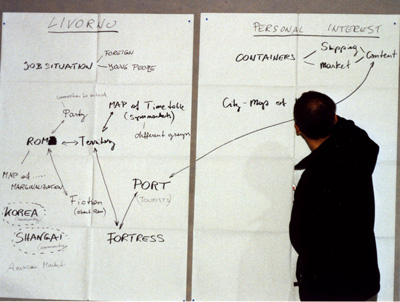20th>3th november 2007
Livorno, Bottini dell'Olio
Considering the set of rules and values of a society as a point of balance between parts sometimes opposed, it is easy to understand how such rules may for someone be felt as a limitation to one's own liberty. It is straight from this realization which the project Border Rescue (2004) by Social Impact was born. The Austrian artistic corporation from Linz has covered and made a map during days of walk of the border between Austria and the Czech Republic to outline the paths for safe immigration in Europe. The border then, as sheltering nest from one point of view, but, if viewed from the other side, also as limitation. And it is straight assuming the point of view of the other that Social Impact has described the borders of Europe to make them possible to be crossed in a safe way without risking life in adventurous passages or paying criminal organizations. From this research the publication of a guide and of its online counterpart was born which can be downloaded for free. The guide houses the maps of the border; on them the passages are marked with the description of the points of reference to be followed along the way. E45 /// on the Situation of the Sex Workers Along the E55, 2005 is another of the main projects by Social Impact with which, starting from a social emergency, the group looks for innovative solutions. The project after a phase of survey of the emerging needs of the prostitutes who work along the E55, the highway which crosses central Europe, has planned, achieved and distributed a guide for the prostitutes to work safely. The guide contains both suggestions about the language, for one can often encounter German customers with prostitutes coming from the Czech Republic, and approach techniques elaborated by criminal psychologists to behave with the customer trying to avoid difficulties and dangers.
With the same approach, full of social analysis and with capability of territorial intervention, the workshop of Social Impact was carried out in the city of Leghorn with the young artists of Networking 2007. The workshop started with a direct inquiry about the city followed then by a common reflection on which were its emerging aspects and on which of these it was important to work on. The many ideas proposed, continually wrote down and discussed, gathered on three main analysis points on which afterwards different projects were built: the concept of border as continual process of definition of the self, Rom culture, consumption as potential moment of levelling the ethnic differences. Once the intervention areas had been identified, the main part of the workshop was devoted to the definition of the projects to be carried out. Starting with an idea on which to work proposed by the participants, the latter was submitted to analysis through a series of questions which Social Impact puts under the concept of
"responsibility". |
This series of questions concerns: the aim of the project, by who it is proposed, the research and the necessary skills to achieve it, the supporters and the opponents to its achievement, the blocks, the enlarged audience, the involved participants and the forms of communication, the hoped benefits for the involved actors and the expected changes in terms of social behaviour and of non-hierarchical and democratic empowerment. The analysis complexity for which the initial idea is assessed enriches the project making it more and more efficacious and efficient compared to the original idea. It is through this order of things that the projects then presented during the final opening were elaborated. 110 RomA is the title of a magazine about Rom culture. The goal is that of making Rom culture known going beyond the common stereotypes. The magazine, made by the Rom themselves, includes various columns related to fashion, food, way of living and urban legends about Rom population. 110 is the number of Rom living in Leghorn, a very small number compared to the great clamour which their presence often provokes. On the cover of issue number zero of the magazine there is Saint Sarah, the saint of the Rom. A parallel project to 110 RomA experimented the possibility of making a series of interviews to Rom people asking them which questions they wanted to do to Italians and, vice versa, asking Italians which questions they wanted to do to Rom. The questions put together on a video one after another and then presented in a square of the city create a platform of discussion in which each passer-by is called to give an answer in the first person. Is there a space for communication beyond the reciprocal representations which different social groups can give one of the other? How is it possible to create and cover that space of relation in a non-authoritarian way? The project The birth of an empire concerns the trend to build fences around oneself to part from the rest and manage to define an I opposed to another. The simple act of digging a hole around one's own feet represents and clarifies in an ironical manner this way of acting.
Good advice instead, focuses on the consumption of goods and on the social dynamics linked to it as point of observation which potentially suspends the ethnical or origin differences. The project was born from the idea of searching the differences in the styles of consumption of the natives and of the migrants of the city of Leghorn. After the first interviews done at the exit from the supermarket it was clear that the greatest part of the customers, it did not matter of which nationality they were, was looking for the same goods to buy with similar quality standards. What would happen if a guide of the best purchases among the shops and the supermarkets of Leghorn was published following the migrants' suggestions?
Published on Tafter.it on January 4, 2007
|






